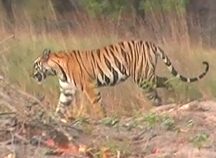CHANDRAPUR: Conservationists and wildlife activists in Chandrapur have joined hands to protect forest from the threat posed by large scale mining around Tadoba Andhari Tiger Reserve. In the backdrop of fact-finding report prepared by NGO Greenpeace India on deterioration of tiger corridors of TATR due to extensive mining, massive awareness campaign was launched by group of NGOs in the town.
Half a dozen tiger mascots accompanied by hundreds of students marched along the streets on Monday carrying placards about saving tiger and conserving forests. Students even painted their faces in stripped pattern of tigers to convey strong massage for protection of forest and tigers. Wildlife activists connected to Green Planet Society, Eco-Pro organization, Wildlife Protection Society of India and campaigner, Greenpeace India, Preeti Harman joined the awareness rally.
Harman said, "A total of 2,058 hectares of forest land has been given for mining in Chandrapur since year 2000. Even as coal block allocation to Adani mine in Lohara forest has been canceled after strong protest, the threat of the same block being allotted to others looms large. The wildlife corridors connected Tadoba forests with Chaprala, Indravati, Bor, Navegaon, Kanha and Melghat have been cut off due to growing mines. TATR has turned into a island of tigers from where they have not route left to move to the adjoining habitats."She warned that allocation of more coal blocks around Tadoba is in the offing, as coal ministry has plans to allocate mining blocks even in no-go zones. She claimed that deterioration of forest corridors is one other reason for rise in wild man-animal conflict in Chandrapur district. She alleged the government of not being serious towards protection of forests and demanded for formulation of concrete wildlife policy. She informed that fact finding report 'Undermining Tadoba's Tiger' prepared by Greenpeace was recently released in Delhi and copy of the same was submitted to forest and environment minister and coal minister.
Bandu Dhotre of Eco-Pro pointed out that mining in Durgapur and Padmapur coal mines, mining projects in Chichpalli, expansion projects of Durgapur and Padmapur, coal blocks in Lohara and Agarzari pose threat to corridors leading southwards of Tadoba. Similarly Murpar mine, proposed mines in Bandar, Surmanjiri, Bhansuli, Bhagwanpur, Nand-I and Nand-II and expansion Murpar mine threatens the northward corridor of Tadoba. The proposed Human dam project and Gosikhurd right bank canal threatens to block entire the North-East corridor leading out of Tadoba forest, he warned.
Suresh Chopne, president of Green Planet Society, said that they intend to raise strong opposition to proposed mines around the TATR. "We will try to get support of politicians and forest department."for sake of tigers and forests. We are ready to take to roads to protest against the mines and even knock the doors of court of law if situation demands," he said.




